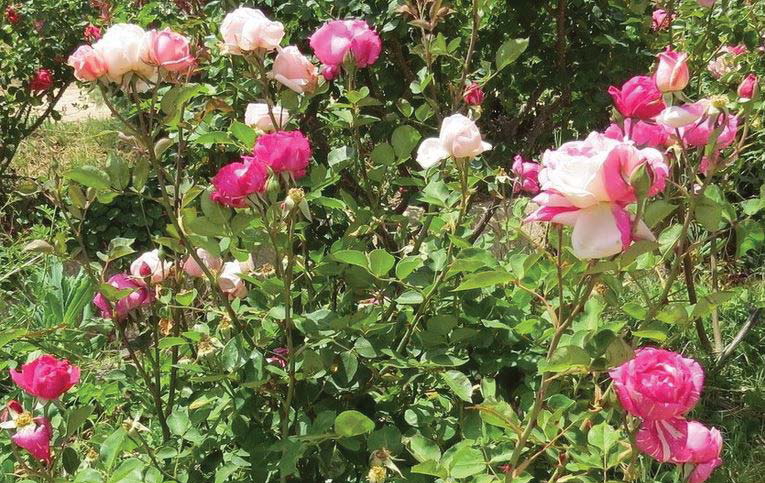More Jargon: Sporting and Reverting.
Margaret Furness, Barossa & Beyond
Re-written from an article in the Journal of Summer 2013, for new members.
Sporting and reverting
A gene mutation producing a change in a branch of a rose bush is called sporting. If the change persists, the sport is said to be stable, and budwood or a cutting from the branch can be used to produce a “new” rose.
Common sports have a different colour from the parent bush, eg. apricot Perle d’Or 1875 sporting to soft yellow Ravensworth 1999, in Tasmania. Many climbing roses are sports of bush roses (Climbing Perle d’Or 2004 was found in Mildura). A spring flowering Rambler may rarely sport to a repeat-flowering dwarf plant: the classifiers call them Polyanthas, out of despair. Félicité – Perpetue, Sempervirens Rambler, sported to the dwarf Little White Pet. The sequence can be complicated; Daybreak (double-flowered rambler, spring-flowering) gave New Dawn (double repeat-flowering climber), which gave Awakening (very double).
If two roses aren’t distinguishable by current plant DNA testing, one is assumed to be a direct or indirect sport of the other.
A mutation can cause more than one change. Pink Quatre Saisons produced white, mossed Quatre Saisons Blanc Mousseux / Four Seasons White Moss.
Not all variations are sports. Some roses, for example the Teas, are highly sensitive to, and responsive to, even slight changes in conditions, and will vary in bloom form and colour as well as growth habit as a matter of course.
Some sports are unstable; when a sport changes back to the parent, it’s called reverting. Many bushes of Quatre Saisons Blanc Mousseux have both white mossed and plain pink flowers. Radiance (pink HT 1908) sported to Red Radiance (reddish pink), which produced Mrs Charles Bell (described as seashell pink, presumably depends on the seashell) and Careless Love (striped). Old plants of Careless Love at Renmark show all those colours, and some parti-coloured blooms.

It’s important when taking budwood or cuttings of a climber, to take the material from a climbing branch. Otherwise you may just get a bush form.
Reverting and sporting can be useful for identifying a rose, but if a foundling changes, we may not know which came first.
Reverting can also be useful for retrieving the lost. The rose imported decades ago and distributed as Reine Marie Henriette 1878 turned out to be its offspring Noëlla Nabonnand 1901. We do have a striped sport of RMH, Mme Driout, in Australia, so we’ve been watching it for reversion to RMH. Last November I was telling this story to an overseas visitor, and was stopped mid-sentence by seeing two unstriped blooms on my plant. It was very close to the time for collecting budwood, so we won’t know whether it was a stable reversion till the plants budded from those branchlets flower.
Watch this space.
